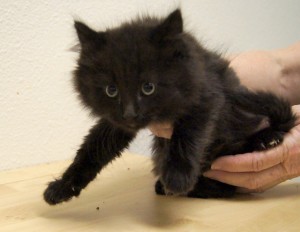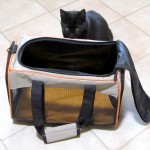Are you one of those people who hate taking their cat to the veterinarian?
 You’re not alone. Research says that 38% of people with cats get stressed just thinking about a vet visit. Most people say their cats hate going to the vet even more than they fear taking them. Most cats do indeed have vetophobia.
You’re not alone. Research says that 38% of people with cats get stressed just thinking about a vet visit. Most people say their cats hate going to the vet even more than they fear taking them. Most cats do indeed have vetophobia.
Cats need veterinary care just as much as dogs do, but get half the care. You can help keep your kitty healthy with regular veterinary visits. Here are some things to make it easier on your cats to get the health care they need.
Make the Carrier Fun
Leave the carrier out and regularly feed their favorite treats in it, making it a pleasant place to hang out. Keep the same bedding in the carrier so their scent travels with them. Once they are comfortable in the carrier, start briefly closing the door, then build up time with it closed. From there, you can briefly pick up your cat, building up longer periods of time being carried around the room and then the house.
Cover the Carrier
Drape a towel over the carrier when you have to travel. Cats do better in quiet, dark places, so eliminating the sights and sounds of travel will make them less afraid.
Practice Car Rides
Once they are used to the carrier, do some practice runs. Start by just taking them to the door, then back. Then take them down to the car, then back. Gradually work up to spending time in the car just sitting, then with the motor on, then driving around the block. Don’t forget the treats!
Play Doctor
You can get your cats more used to a real exam while you’re relaxed and petting them. Start by gently handling their paws. Gradually increase the time you can hold them. While you’re scratching their chins, gently start to open their mouths and touch teeth. Again, treats always help.
Calm & Soothe
Along with staying calm yourself, you can spray a little Comfort Zone Feliway on their bedding to make the trip less stressful. You can also give them Bach Rescue Remedy, either the version for pets or some that’s diluted with water (available at health food stores).
Handle Gently
When it’s time to go to the vet, withhold food the night before. This will make your kitty more receptive to treats during the process. Shut your cat in the room with the carrier, which should now be a friendly place to be. Lure your kitty into the carrier by putting very high-value treats in the back of the carrier. Once the kitty goes into the carrier, gently shut the door.
If your cat does not go into the carrier on its own, you may have to place him or her in there. Make sure the carrier is up against something immovable in case you have to push a bit, but firmly nudge your kitty inside. If the kitty refuses to go in, you may have to tip the carrier on end and put him or her down in the carrier rear end first. If that happens, please be sure to give a few very high-value treats once the kitty is inside.
Once you’re at the vet (and please make sure your vet practices Fear-Free or Low-Stress handling, below), remove the top of your carrier and cover your kitty with the familiar towel. Many vets will examine the cats from within the carrier, which will be less stressful for them. Other vets treat their feline patients at floor level, using calming toweling techniques.
 A single scary visit to a vet can set up a cat (and you!) for a lifetime of fearful visits. If you’re searching for a new veterinarian, you can ask some questions that can tell you if the practice is cat-friendly.
A single scary visit to a vet can set up a cat (and you!) for a lifetime of fearful visits. If you’re searching for a new veterinarian, you can ask some questions that can tell you if the practice is cat-friendly.
- Does your vet have a separate or screened waiting area for cats and dogs…or at least allow you to wait in the car with your cat?
- Does your vet have an exam room just for cats…or at least make an effort to neutralize unfamiliar scents that can be frightening for a cat?
- Does your vet make an effort to have soothing music or reduced noise? Cats hearing is 30% more acute than dogs and 60% more than ours, so even normal clinic noises can be terrifying for them.
- Is the staff at your vet’s practice trained in feline-friendly handling techniques, including Low Stress (like that of Dr. Sophia Yin) or Fear-Free handling for cats? Ask your vet if he or she is using the Top 10 Fear Free Techniques.
- Is your vet familiar with the AAFP protocols for treating cats, including their updated Vaccination Guidelines? Does your vet recommend lowering your cat’s fear with AAFP instructions for going to the vet?
Here are more articles about the Fear-Free movement in the veterinary world to help make both you and your cat better able to deal with vet visits:
Fear-Free Veterinary Visits for Your Cat
Top 10 ways to get started with Fear-Free veterinary visits
Ways to Reduce Stress in Cats: Make it Fear-Free
And here are some videos to show how low-stress or Fear-Free handling works and how important it is to your cat (and you!):
The following are two examples of what you do NOT want in your veterinary handling. In the first video, this cat has been repeatedly terrified at previous vet visits and is now labeled “angry.” This sets the cat up for being treated as if he has a choice in his response to his handling. He does not. If this facility were truly Fear-Free, this cat would have been sedated so he did not have to be put through what, to him, is clearly torture. This handling is almost certainly contributing to the illness this cat is experiencing.
In the second video, what should have been an extremely simple procedure, a vaccination, is turned into an extremely fearful event for the cat with mishandled toweling and manhandling. This cat has also been pushed far, far past his fear threshold. Labeling him “Psycho Cat” sets everyone up for the worst experience possible.
Please make sure you go to a veterinary clinic that has better cat-handling skills than either of these do. They do exist! Call us at Happy Cats Haven at 719-362-4600 and we can refer you.
You can also read more about cats and vets at Dr. Becker’s great website, Healthy Pets.






Awesome article!!
Sherri